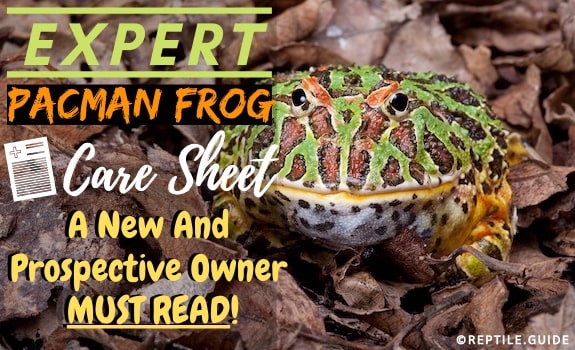A unique amphibian, Pacman Frogs make wonderful pets for people of all experience levels in exotic pet care due to their forgiving nature, ease of care, and the availability of captive-bred specimens.
Whether you’re a beginner who has never owned a frog before, or if you’re the person everyone comes to with questions about amphibian care, this Pacman Frog care sheet is chock-full of tips and tricks designed to help your new pet live a long, happy, and healthy life.
And once you’re done perusing this in-depth guide? Well, you’ll be able to consider yourself an expert on Pacman Frogs!
Here’s What You’ll Learn In This Pacman Frog Care Sheet:
- Background information on Pacman Frogs
- Where to buy a healthy Pacman Frog python (plus what to look for!)
- Relative cost of a Pacman Frog (including rare morphs)
- Proper diet for all ages
- How to properly set up a Pacman Frog habitat
- Health concerns to be aware of (plus how to prevent them!)
- Handling & bonding tips
- & So much more!
Also known as “Horned Frogs” or “Fantasy Frogs”, Pacman Frogs are renowned for their eating style and the folds of skin that are located over the eyes, giving the frogs the appearance of horns.
Undeniably one of the best pet frogs, these adorable chubby guys will provide hours of delight, especially when they eat in true Pacman style (more on this later).
Any creature or item that hops, crawls, or otherwise lands in front of this mouth with legs is fair game, disappearing in a single gulp down the gullet of a Pacman Frog.
This frog is an easy species to care for… provided you DON’T stick your fingers within chomping distance of its voracious mouth.
For the more experienced frog care-takers, the variety of Pacman Frog color morphs is beautiful to behold. There are at least 18 popular color morphs available to choose from, creating a truly unique pet.
With all of this being said, let’s dive headfirst into this Pacman Frog care sheet!
In This Article
Pacman Frog Background Information
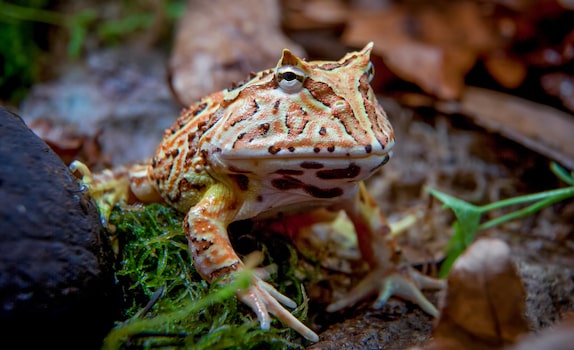
The Pacman Frog can be found all over South America, from Venezuela and Columbia to Peru and the surrounding areas. They enjoy living in tropical and subtropical grasslands, marshes, lowland forests, ponds, and freshwater marshes.
However, research has found that where they call home has significantly relied on climate fluctuation over the past 100,000+ years.
With their beautiful camouflage coloring of green, brown, yellow, and red, they blend in well with the leaf litter on the forest floor as they lie in wait for their prey.
Relatively inactive frogs, Pacman Frogs spend most of their lives half-buried in the substrate. They typically only move around to capture food, reach temporary ponds during the breeding season, or switch hiding places from time to time.
Captive-bred Pacman Frogs make excellent pets, since you can ensure the pet you purchase from a reputable breeder is parasite-free and healthy. With a healthy, well-cared for Pacman Frog, you may enjoy your pet’s company for 10 to 15 years, if not longer.
Most captive-bred baby Pacman Frogs are sold when they’re around the size of a quarter, while adults can reach three to six inches in length and width.
Pacman Frogs demonstrate sexual dimorphism, in which females are larger than males.
Large females may weigh up to one pound, after reaching maturity at 18 to 24 months of age. Adult males are usually smaller than their female counterparts, and can vary in size depending on their species.
Most healthy Pacman Frogs are relatively round in appearance, and have unique skin folds above their eyes that give them the name “horned frog”.
Female Pacman Frogs are prolific breeders, depositing up to 2,000 eggs at a time! After the tadpoles emerge, they begin satisfying their voracious appetites with anything in sight, including their smaller siblings.
The largest tadpoles in the pool often consume smaller ones, and this disturbing habit can continue on even after they grow legs.
Keep their cannibalistic nature in mind if you plan on breeding Pacman Frogs, as they should be confined separately for their safety.
The common name of these special frogs – Pacman Frog – actually represents EIGHT species that differ slightly in colors and patterns.
They come in a variety of color morphs, ranging from strawberry red to mint green or albino.
Another tidbit that helps make these frogs incredibly interesting? They possess a cool characteristic that makes them an even more intriguing pet…
When a Pacman Frog’s substrate dries out or food is scarce, it will encase itself in a tough outer skin to protect it from drying out. The frog won’t move and will look like it’s dead. However, once the frog is rehydrated by adding moisture to the environment, it will shed this outer skin and eat it!
This protective mechanism makes it MUCH more difficult to inadvertently kill your Pacman Frog through lack of a proper diet or low humidity.
Besides being easy to care for, Pacman Frogs are relatively inexpensive to purchase, particularly if you are looking for a common color morph.
Standard Pacman Frogs may only cost $20, while more unique colors can easily triple that.
Your new pet’s enclosure and habitat setup will cost more than the frog itself, so be prepared to spend at least a few hundred on your Pacman Frog, enclosure, habitat accessories, substrate, and food.
🔑 Pacman Frog Background Key Takeaways: Pacman Frogs are fascinating frogs that inhabit much of South America and spend their days buried amongst the forest floor waiting to guzzle down prey with their cavernous mouth! Relatively small in size, adults typically reach between 4-7 inches (some can get to 9 inches) and weigh at most around a pound. They can live for an impressive 10-15 years in captivity. They’re also difficult to kill, making them a great hardy pet option for everyone.
Where to Buy a Pacman Frog
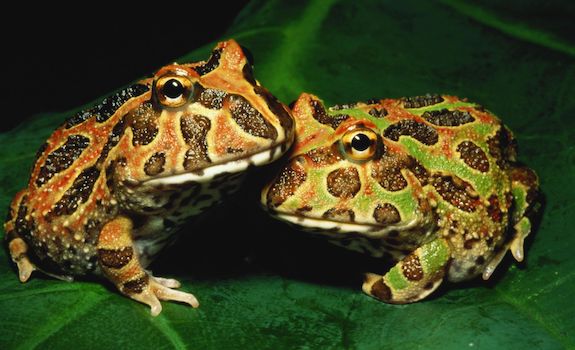
Since Pacman Frogs are easy to care for and make an interesting conversation topic with their unique features, they are relatively common among pet stores, reptile and amphibian expos, and frog breeders.
While pet stores can stock healthy animals, they rarely have the specialized experience necessary to provide personalized care for their various species.
Ideally, search for a Pacman Frog breeder. Not only will they likely have higher-quality pets, they can be an invaluable resource for future care-taking questions.
When selecting a new pet to welcome into your home, keep the following criteria in mind:
- Avoid picking a thin frog, since these frogs are meant to be round
- Look for a frog with a round body, moist skin, and clear eyes
- Ask to watch the seller feed the frog to check for a good appetite
Beginner frog-keepers would be better off starting with a large juvenile Pacman Frog, rather than one who just reabsorbed its legs and moved to dry ground.
Frogs at this life stage are hardier and you get to experience their growth and development while forming a tight bond.
If you’re just getting into frog care-taking or are building your breeding stock, you’ll be delighted at how inexpensive Pacman Frogs can be.
Your standard Pacman Frog morphs can be found for under $20 , while more unique morphs or species—remember there are eight different Pacman Frog species can cost up to $100.
However, don’t forget to factor in the cost of shipping IF purchasing from a breeder, since the shipping cost will likely be higher than the price tag on your new pet.
🔑 Pacman Frog Purchasing Key Takeaways: When searching for a Pacman Frog, it’s best to purchase from a breeder. Expect to spend around for a standard morph and up to 0 for more rare morphs. Make sure you examine the body and appetite to ensure your new pet is healthy. Lastly, beginners are better off with large juveniles.
Pacman Frog Diet and Feeding Guidelines
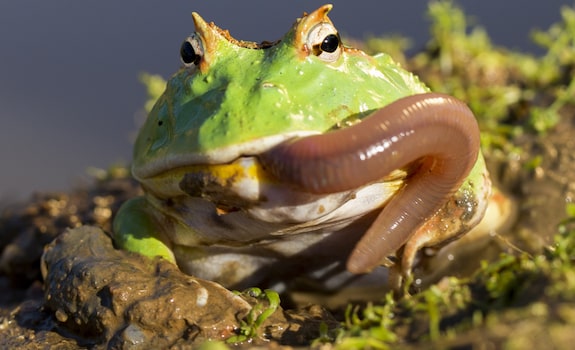
Depending on the size and body condition of your Pacman Frog, you can likely feed your pet for under $20 per month.
This estimate is based on feeding your frog a few roaches up to every other day or just twice a week, depending on how round your frog becomes.
While Pacman Frogs ARE meant to be round like their namesake, they can quickly become obese because of their ferocious appetite, so monitor their body condition carefully and adjust their food intake as needed.
Components of a Pacman Frog Diet
Have you ever wondered what do frogs eat?
To keep your Pacman Frog in optimal health through balanced nutrition, a staple of crickets and/or roaches is best (a classic amongst the best frog diets).
However, Pacman Frogs can also eat night crawlers, earthworms, fish, and small mice. Although adult Pacman Frogs can fit a pinkie in their cavernous mouths, only offer these small mice as treats, since they are high in fat and can cause your pet to quickly pack on excess weight.
Ensure your frog has the BEST in nutrition by feeding your pet gut-loaded insects that are fed a nutrient-dense diet.
Dust the insects before feeding with a high-quality vitamin and mineral supplement for bone growth. Without the vitamin D and calcium found in dusted, gut-loaded insects, your Pacman Frog can suffer from serious health issues.
Pacman Frogs have exceptionally well-developed vomerine teeth to help them with their carnivorous diet. If you’re not sure what “vomerine teeth” are, check out our dedicated frog teeth article!
Or if you want to get to the weird (yet interesting and important) side of the internet, read what you never knew about frog poop!
How Often to Feed a Pacman Frog At Any Age
Just like White’s Tree Frogs, your Pacman Frog can essentially eat whatever prey item will fit inside its mouth. In fact, this is why they’re classified as gape-limited predators!
For example, a juvenile Pacman Frog may only be able to handle small crickets or roaches, while a full-grown adult can gulp down an entire nightcrawler with no problem. This is due to their large jaw, which they can use to devour even comparably large prey. Other frogs, like the chubby frog (Asian Painted Frog), have more narrow mouths in comparison to their body size and cannot each large prey.
When feeding your Pacman Frog, offer only enough insects that can be consumed overnight. If there are uneaten insects in your frog’s enclosure after several hours, feed your frog fewer insects in the future.
How Often to Feed Baby Pacman Frogs
Dust invertebrate foods, such as crickets or roaches, with a vitamin and mineral supplement and feed to your juvenile Pacman frog two to three times weekly.
How Often to Feed Adult Pacman Frogs
Adult Pacman frogs may need to be fed as frequently as every few days, while some can last a week between meals.
Gauge your frog’s body condition and appearance before feeding to see if your pet is too thin or too round, and adjust your feeding schedule as needed.
Keep in mind that adult frogs are even MORE aggressive when eating than juveniles, so it’s best to use forceps to avoid injury.
🔑 Pacman Frog Diet Key Takeaways: Feeding your Pacman Frog will be relatively cheap, and as such, you can expect to spend less than $20 a month on food. Babies will need to eat every couple of days, while adults will vary from frog to frog, with some able to go a week between feedings. All feeders should be dusted with vitamin and mineral supplement.
Pacman Frog Habitat and Tank Setup
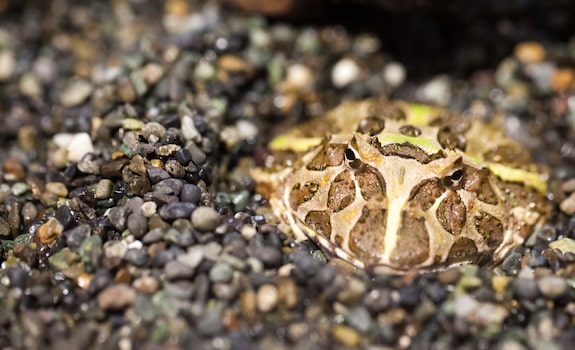
Next up in our Pacman Frog care guide, we’re going to discuss everything you need to know about setting up a proper enclosure.
Getting their enclosure on point is one of the absolute first things you MUST do when bringing your new pet home. That’s right, it even takes precedence over picking out a really cool name.
Size of the Enclosure
Pacman Frogs are sedentary creatures who spend most of their time lying in wait for their next victim to wander by, only emerging to pounce on their prey.
They burrow down into the substrate with only their eyes—and horns in some species—poking out to keep watch for their next meal. Since Pacman frogs spend such large portions of their lives immobile, their habitat does NOT need to be spacious.
Baby Pacman Frogs can be kept in small, plastic reptile enclosures, and, while adults will be content living in habitats of 10 to 20 gallons, they thrive in larger enclosures.
Type of Enclosures
When setting up your Pacman Frog’s enclosure, you can choose from a variety of materials…
Glass aquariums are the MOST common choice for adult frogs, while babies are often kept in small plastic habitats until they grow larger.
Regardless of what option you choose, ensure you have a tight-fitting solid lid with moderate holes to keep your pet contained and safe from other animals in your home.
A mesh lid may allow too much ventilation, which causes faster evaporation and may dry out your frog.
Ideal Temperature Gradient
Many sources state that Pacman Frogs need temperatures as high as 75 to 85 degrees Fahrenheit to remain comfortable…
While their natural environment does reach such temperatures, Pacman Frogs spend most of their time buried in the cool ground, avoiding such high temperatures.
However, Pacman Frogs in captivity don’t have as much substrate to burrow deep, plus the air does not move in their enclosure like it would in their home environment. Based on these facts, normal room temperatures between 65 and 85 degrees are adequate for Pacman Frogs.
Avoid using a radiant heat source for your frog, since these heat sources dry out sensitive amphibian skin.
Unlike reptiles, such as snakes, Pacman Frogs do NOT require a temperature gradient.
They are comfortable with a constant temperature throughout their entire enclosure and natural lighting, although a fluorescent bulb IS recommended.
⭐️ Fun Fact: Did you know, that scientifically speaking, toads and frogs are NOT classified separately from a taxonomical standpoint? Instead, they are more casually differentiated based on physical and reproductive differences, such as whether or not their skin is slick and where they lay their eggs. Can you name any of the other key differences between toads and frogs?
Ideal Humidity Levels
All amphibians require high humidity levels to prevent dry skin, and your Pacman Frog is no exception. For your pet, strive for 80% humidity, which can be achieved by misting the enclosure regularly.
Avoid saturating the habitat’s substrate, but ensure it remains damp between misting sessions.
Keep your Pacman Frog happy and hydrated with plenty of fresh, clean water available at all times.
Proper water sources can include:
- Bottled spring water, which can get expensive
- Aged water, which is created by allowing chlorinated water to sit in an open container for 24 to 48 hours so the chlorine can dissipate
- Filtered tap water should be run through a sediment and activated charcoal filter or treated with a water conditioner to remove chemicals
- Distilled water should only be used for misting, not as a main water source due to its lack of natural minerals
Since Pacman Frogs have semi-permeable skin, toxins can easily slip through their skin barrier and cause systemic damage. Without removing chlorine, fluoride, ammonia and other chemicals from your pet’s water, your frog can suffer from a variety of illnesses.
Keep in mind that your Pacman Frog is NOT the sort of frog who enjoys swimming and living in the water, so only provide a small, shallow water dish for soaking purposes, NOT swimming.
With properly misted substrate that remains damp, you may not even need a water dish for your frog.
Improper temperatures and low humidity can cause your Pacman frog to become sluggish and lose its typically voracious appetite.
One effective way to adjust humidity levels without raising the temperature is with a fogger.
Because of how critical temperature and humidity is to your frog’s health, an important habitat accessory is a high-quality digital thermometer and hygrometer combo.
Tip: Have more frogs? Check our guide to the best frog tank and habitat for frogs in general!
Substrate
Since Pacman frogs love to burrow into the ground to lie in wait for their next meal, ensure your pet’s habitat caters to this desire.
Choose a substrate that allows your frog to dig into the ground to fulfill that need to burrow. The ideal substrate will also retain moisture, since frogs require high humidity levels to remain healthy.
Excellent substrate options for your Pacman Frog include:
- Cypress mulch
- Orchid bark
- Coconut husks
- Soil
Decor and Accessories
The highlight of your Pacman Frog’s day is finding the PERFECT hiding spot to dig into and wait for the next meal to wander by.
While much of your frog’s habitat needs revolve around the ideal substrate for burrowing, Pacman Frogs also enjoy hiding places at each end of their enclosures.
Live or artificial plants create excellent hiding spots, while live golden pothos plants also help process feces and carbon dioxide.
Pothos plants are the most commonly chosen live plant for Pacman frog habitats, but any hardy, non-toxic plant that can handle low light and high humidity can thrive.
If you want, go compare a White’s Tree Frog’s habitat setup to the one of a Pacman Frog!
🔑 Pacman Frog Enclosure Key Takeaways: Pacman Frogs require pretty straight forward enclosure, with no additional heat or UVB source being required. They simply need plenty of natural light, a temperature between 65 and 85 degrees Fahrenheit, moisture-retaining substrate for burrowing in, plenty of humidity (aim for 80%), and live pothos or otherwise hardy artificial plants.
Pacman Frog General Health Information
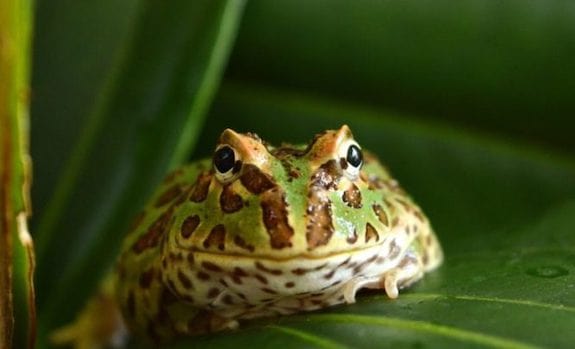
Although you won’t notice much of a difference in your Pacman Frog’s activity level if it’s feeling a bit under the weather, you’ll likely spot a significant change in appetite if something is amiss.
If your frog’s appetite slacks off, a health issue could be afoot. While Pacman Frogs are generally easy to care for and hardy creatures for amphibians, they do experience their fair share of illnesses.
Some of the most common diseases to watch out for in your pet include the following listed illnesses…
Corneal lipidosis
Despite how entertaining it is to watch your Pacman Frog gulp down an entire small mouse in one bite, limit these special treats to rare occasions. Mice are high in fat, which could lead to corneal lipidosis.
A milky, opaque film over or one or both eyes can indicate a diet that is high in fat content, such as feeding too many mice. A high-fat diet can cause lipid buildup on the eyes of your frog, which can appear similar to cataracts in people. Other reasons your frog may develop a milky corneal film include unclean water conditions or a humidity level that’s too low.
Avoid potential corneal films by feeding your frog a high-quality, nutritionally balanced diet with few high-fat prey items, and by providing fresh, dechlorinated water and a damp environment.
Foreign body ingestion
Pacman Frogs live up to their namesakes, gobbling any object placed in front of them. Unfortunately, this ferocious appetite can land your frog in trouble…
If you decorate your pet’s enclosure with items that are small enough to be snatched up by your frog, consider feeding your pet in a different enclosure that is devoid of decoration.
Small rocks, pebbles, and tiny decor items can be gulped down as your Pacman Frog blindly lunges at its meal.
Since Pacman Frogs close their eyes when lurching at their prey, they can easily ingest small objects in addition to a cricket or roach.
Nutritional Secondary Hyperparathyroidism or “metabolic bone disease”
Nutritional Secondary Hyperparathyroidism, or metabolic bone disease, is a skeletal system disease that affects captive reptiles and amphibians.
This disease is generally caused by a lack of calcium and proper supplementation in the Pacman Frog’s diet. It can be identified by a drooping jaw or the inability to latch onto prey with its bony teeth.
Metabolic bone disease causes weak and brittle bones, which can lead to deformed bones, bones that break easily, and eventual death.
Always supplement your frog’s prey items by dusting them with a calcium powder or high-quality vitamin and mineral supplement before offering them, and your pet will hopefully never experience this disease.
Toxic Out Syndrome
An odd-sounding disease, Toxic Out Syndrome refers to the condition that occurs when a Pacman Frog sits in dirty water or substrate and absorbs toxins through the skin.
Erratic jumping and stretched-out hind legs generally indicate Toxic Out Syndrome.
If left untreated, the illness will escalate and potentially lead to death.
The best way to treat Toxic Out Syndrome is to place your affected frog in clean, unchlorinated water until the signs of illness subside. Change the water every couple of hours until your frog’s behaviors normalize. For severe cases, seek an exotic veterinarian for treatment.
To prevent this diseases, always keep your frog’s habitat clean and sanitary by supplying clean, fresh water and frequently replacing soiled substrate.
🔑 Pacman Frog Health Key Takeaways: If you can provide your Pacman Frog with a diet that is rich in nutrients without being too fatty, you’ll be well on your way to keeping them healthy! On top of this, you’ll also want to ensure their enclosure is spick and span so they do not absorb any bacteria through their sensitive skin and become sick.
Pacman Frog Handling and Bonding Tips
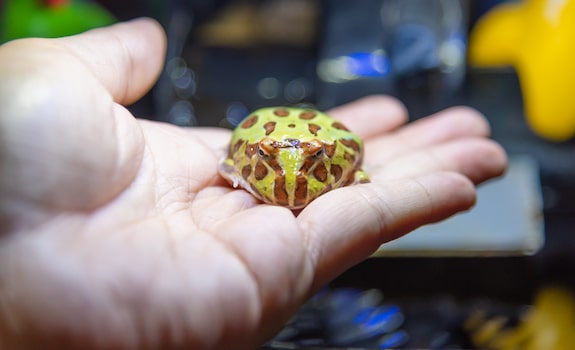
Like all amphibians, a Pacman Frog’s skin is EXTREMELY sensitive to touch and toxin transfer.
To keep your pet safe, handle your frog as little as possible, using gloves as needed. Use frog-friendly water to dampen your hands or gloves before handling your pet to foster additional comfort.
Although you may not be able to handle your Pacman Frog much, you can still form a bond with your pet!
Your frog will see you as the source of food, and while you may think your pet is lashing out because of an aggressive nature, that is rarely the case.
Instead, your frog is hungry and devours any item placed in front of its gaping maw. Be prepared for your frog to “attack” you and potentially land a bite, simply because your pet believes you are food. And, despite the fact that frogs lack true teeth, bony points on the jawbone can still deliver a piercing punch.
Since you can’t handle your Pacman Frog much, and it displays a tendency to bite the hand that feeds it, these frogs may not seem like they make good pets. However, this is simply NOT the case!
Pacman Frogs make wonderful pets due to their:
- Ease to care for
- Affordability
- Low maintenance
- Entertainment value
- Varied and beautiful assortment of morph
- And so much more!
🔑 Pacman Frog Handling and Bonding Key Takeaways: Not exactly the most ideal option for those who like to hold their pets, Pacman Frogs are best handled at a minimum due to their tendency to mistake your hands for food AND the sensitivity of their skin. However, what they lack in cuddly affection they absolutely make up for in ease of care!
Is a Pacman Frog Right for YOU?
Now that you’ve made it through this Pacman Frog care guide, you should see that Pacman Frogs are relatively easy to care for and make excellent pets, (provided you don’t stick your fingers in front of their cavernous mouths when it’s dinnertime)!
In fact, due to their ease of care, small habitat size, and simple enclosure setup, Pacman Frogs make wonderful pets for ANY level of frog-keeper.
While inexpensive to begin your Pacman Frog addiction, more unique and colorful morphs can become a little pricier, but usually stay under $100, making this pet more economical to collect and breed than many other reptiles and amphibians.
For a great beginner frog, a gorgeous color morph to breed, or a fun creature to feed in front of company, look no further than the truly unique and fascinating Pacman Frog. If the Pacman frog is not for you, check out the White’s tree frog instead!
Alternatively, axolotls are common in the pet trade and are fully aquatic despite developing lungs. Use our baby axolotl guide to learn how to care for them!
